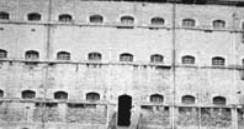
The Finmere Record

We will complete the editing and design of the Millennium History of Finmere in the first or second week of December—two months later than planned. Then we must check and proofread it. I have considered rushing to press for Christmas or the New Year but, after four years and at least a thousand hours of work by our team, I do not wish to cut corners at this stage. A new publication date has been set for the end of February 2001 when we will distribute free copies to every house in Finmere parish and Little Tingewick, funded by the Parish Council and donors. I am sorry for the delay and hope that you will find the book worth the wait.
Andy Boddington
The Finmere Record
SATURDAY, 25 NOVEMBER 2000
Many village histories present a sentimental portrait of rural life in which villagers were poor but law-abiding and noble, with the exception of a few colourful rascals. It is probably true that most villagers were god-fearing and honest—but crime, child abuse, theft and violence were more common than many local history books acknowledge.
Infanticide was a common problem in Victorian England and, in this newsletter, we tell Mary Merrick’s story. She was sent to Oxford for trial after the body of her newborn child was found in a Finmere field and an inquest jury returned a verdict of murder.
One of the most sombre meetings to be held in the Kings Head was the coroner’s inquest held on Monday, 8 February 1858.
The drama had begun three days earlier when George Tompkins and George Freeman were walking towards the Poor’s Plot. As they crossed Kennel’s Field, the farm labourers found the naked body of a newborn girl lying in the water of a ditch. A bloodstained cloth hung on a nearby hedge.
The Poor’s Plot was a field of allotments west of the village, north of Hill Leys (which was not then built).
The men immediately informed the police, probably by sending word to Bicester. The Oxfordshire county police force had been formed the previous June but then, as now, Finmere lacked a police presence. Just one policeman was appointed to keep watch over the ten parishes in the north of the county, including Finmere. That officer was Inspector Thomas Golding, who was summoned to investigate the Finmere body. After his enquiries, he travelled to Haddenham in Buckinghamshire where he arrested Mary Merrick.
At inquest, coroner J. Churchill and ‘a respectable jury’ listened to the evidence from the labourers and John Collier, a Brackley surgeon who described his post-mortem. The jury were left in no doubt about Mary’s guilt and they returned a verdict of ‘wilful murder.’ Mary, aged twenty-one, was committed to Oxford Gaol to await full trial at the Lent Oxford Assizes.

Squalid cells at Oxford Gaol, where Mary was imprisoned for three weeks
On Saturday, 28 February, the High Sheriff of Oxford arrived at the Great Western Railway Station in Oxford to greet Mr Baron Watson and Mr Baron Channell, the Judges of Assize for the Oxford Circuit. Two days later, after much pomp, ceremony, wine and food, the Judges arrived at County Hall to begin work.
Baron Watson took charge of the County Court where Mary Merrick was to be tried. As was then the custom, the jury was drawn from the gentry of the county, who were also the local magistrates. Watson remarked on the pleasure of seeing so many county gentlemen present and swore in a Grand Jury of twenty-three noblemen, with Lord Norreys as foreman.
There were seventeen prisoners to be tried on charges varying from minor theft to murder. Introducing the proceedings, Baron Watson presented a brief synopsis of each case, noting that there were two cases of alleged child murder of ‘very different complexions.’ Such cases, he intoned, rested on whether the child was born alive and had admitted air to the lungs. This was tested by putting the lungs in water but Watson cautioned that:
[This was] a very imperfect test… as a child might, in the course of birth, admit air into the lungs, as if it had breathed, and had been born alive.
Despite the two murder charges, Watson remarked that the seventeen cases before the Jury ‘did not show any great depravity among the population of this county.’ He then launched into a lengthy commentary on crime and punishment. His ‘duty was to hold the scales of justice with an even hand, to protect the innocent and to punish the guilty.’ He wished that he could reform offenders but prison was not the place for reform. It was there to deter others and show that crime could not be committed with impunity. Most of the crimes the Grand Jury would have to deal with emanated from resorting to the public house and from drunkenness. But whatever was to be done was to be done early in life through the medium of a good, sound and religious education. He hoped to see those principles preached and practised throughout the land and, he proudly concluded:
The time will come when, in spite of the pressure of population, the idle, the profligate and the dishonest would be diminished and an industrious, honest and, I would add, religious feeling [will] predominate through the country.
Fortunately perhaps, Mary Merrick was not present to hear this lecture. Later that day, she appeared before the distinguished gentlemen on two charges of murdering of a newborn child and of concealing the birth of the child. Mr Vaughan appeared for the prosecution and Mary was undefended. Unusually, Baron Watson did not offer to appoint a Counsel to defend her. Mary’s sad story was then revealed.
On 30 January, John Merrick had taken his daughter, Mary, to lodge at the house of Hannah and Matthew Watson in Haddenham. John went on to work at Warren Farm, Finmere, owned by Mr Paine. On 4 February, Mary was unwell and went to bed about eight o’clock in the evening; shortly afterwards Hannah took her a glass of elder wine. The next morning, Mary breakfasted at half-past seven and left to visit her father carrying a ‘bundle’ with her. Hannah later went to the bedroom and found Mary’s bed sheets stained with blood.
Mary walked five miles to the train station and travelled to Buckingham Railway Station. She then hiked five further miles to Warren Farm. As she walked from Finmere village, George Tompkins and George Freeman saw her and they chanced upon her daughter’s body half-an-hour later.
An hour later, John heard that the body of a baby had been found and he set out for Haddenham, arriving that evening. Mary had gone to bed and the house was locked. John did not see his daughter until the next morning when they argued again. John insisted Mary should go to bed to rest. Mary retorted that she was well, but acquiesced and retired. John then fetched Mary’s aunt who demanded to know where the child was. ‘Where it was born, for all I know,’ replied Mary, perhaps meaning that it was dead in a field in Finmere, though it is clear that the baby was born in Haddenham.
John Collier, surgeon, took the stand. The child had been born, he said, without medical assistance but he did not see any marks of violence. The lungs were somewhat collapsed but he thought there was partial respiration. He had immersed the lungs in water and they partially floated, but the baby probably had not breathed perfectly.
Dropsy is a swelling of the body, especially in the legs and abdomen and results from the build up of fluid in body tissues. It is often related to a kidney or heart disorder
Mr Watson summed up the evidence for the Grand Jury. He had already suggested in his introduction to the proceedings that he distrusted medical evidence. He now instructed the Jury that the prisoner was tried under a statute passed to prevent the concealment of the birth of a child (it is not clear what happened to the charge of murder). The act of concealing the body must be clearly established if the prisoner was to be found guilty. There was no evidence of that fact and Mary had not concealed what she had done with the child’s body.
The Jury of gentlemen agreed and Mary Merrick was acquitted to applause from the back of the court.
Sarah Hickman of Tackley was tried on the same day for the murder of her daughter. Again, the medical evidence on whether the lungs had inflated caused controversy. Sarah had killed her child by tightening a string around its neck before concealing the body under stones. She was judged ‘weak of mind’ and was found not guilty to murder but guilty of concealing the body. Baron Watson sentenced her to two months in prison with hard labour
The inquest was reported in the Buckingham Advertiser and Winslow and Brackley Record, 13 February 1858, where the name of police inspector is given as Moulden. The trial was reported in Jackson’s Oxford Journal, 6 March 1858, were the name of the inspector is given as Thomas Golding.
This is the fourth in an occasional series of the Finmere Record.